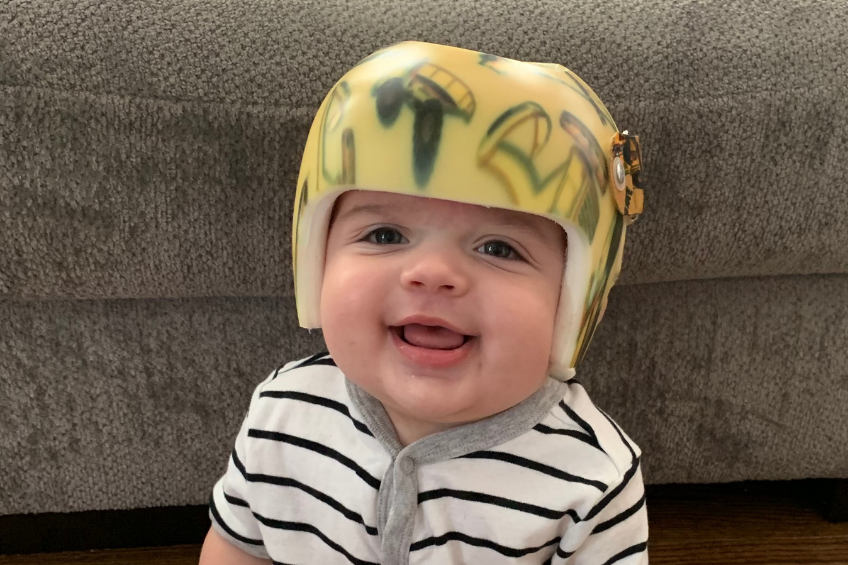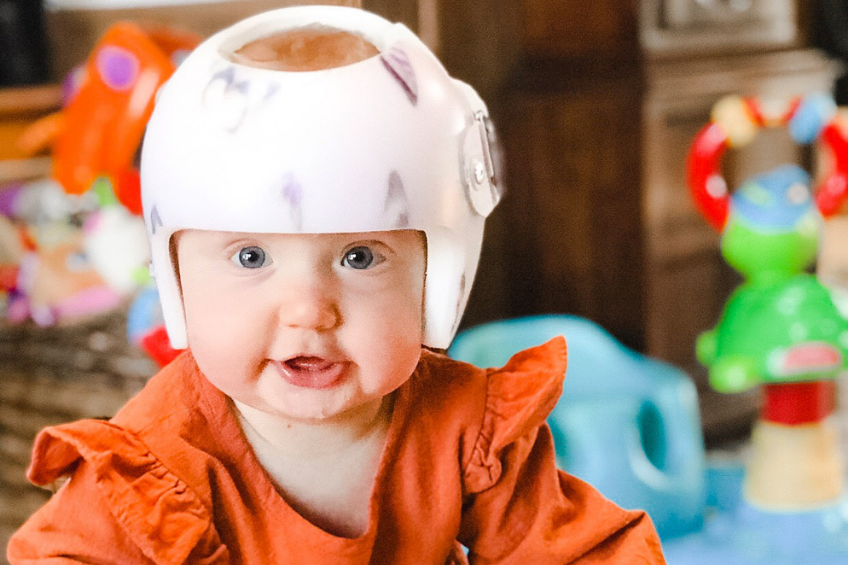Why Should My Baby Wear a Cranial Helmet?
/
Cranial baby helmets are the best thing that has happened since the “Back To Sleep campaign” began. The “Back To Sleep campaign” has saved many babies lives from sudden infant death syndrome but at the cost of a bunch of flat heads. Although costly, cranial helmets correct an otherwise unsightly condition that can affect the confidence of a child as he or she grows up.

Why is it that a cure or therapy starts out innocently only to be abused by aggressive salesmen, emotional critics, and layman evaluators? Let’s use the COVID-19 vaccine as an example. No one wants to look back and remember, however, as I recall people could not wait for the vaccine to become available. The president at that time, Donald Trump, funded the pharmaceutical giants to bring about the vaccine at an unheard-of speed. People would find people they knew who had health care businesses to try to be the first ones to get poked. Even some well-meaning health related businesses got a hold of the vaccines and administered them to people who were not approved to receive it at that time. What happened since then? Look outside your window and notice the amount of people who are still wearing masks. People are more than reluctant to receive it to the point where they are not going back to work because of the Biden mask mandate.
Similarly, medical establishments who perform plastic surgeries or other elective procedures are often criticized for not doing the job that they had promised. A simple and wonderful therapy such as cranial helmet therapy seems so straightforward so how could such an innocent and beneficial development cause criticism, animosity, and controversy?
There are straightforward percentages as to when a baby would need a helmet for plagiocephaly and when the baby could be left alone. The standards are fairly basic as to if, when, and how long the helmet should be worn. Every once and while a story will be posted on the internet about parents who were so unhappy with the helmet their baby was fitted with and how it did not help much. Why should such a standard therapy cause any type of controversy?

Let’s look at some reasons and stories.
1) One mother claimed that the helmet her baby was fitted with did not improve her baby’s plagiocephaly. Not only did that cranial center not help her she had to pay $2,500 out of pocket since her insurance did not cover the helmet. In fact, she ended up having to consult with another cranial therapy center and getting her baby fitted with a helmet that actually worked beautifully.
2) Some internet sites claim that a cranial therapy agency should not be associated directly with a physical therapist. They claim that some questionable agencies will not use the standard guidelines such as Measuring Cranial Vault Asymmetry. There are three categories to characterize the severity of the flat head, mild, moderate, and severe. The claimants are accusing the unscrupulous owners of certain cranial therapy agencies of recommending a cranial helmet for babies with mild plagiocephaly. According to Dr. Gary Rogers, aka, The Noggin Doctor (designer of a special mattress that keeps the baby’s head in a position which he claims will prevent flat head syndrome) if a baby has no head position preference and normal head range motion to both sides with normal motor tone the chances are excellent that even sleeping on their back they will not develop a severe enough case of flat head syndrome to require being fitted with a cranial helmet.
3) Instead of having the referral from a reliable pediatrician who has measured the head and examined it in detail and then recommends a helmet, the parent consults with a physical therapist who is associated with a helmet company that allows the patient to be fitted with a helmet without a prescription from their pediatrician. There may or may not be a financial cooperation between the referring therapist and the helmet company but if there is it could cause a conflict of interest.
4) In most cases only one helmet would be sufficient to solve a baby’s flat head. A helmet that allows adjustments is effective and if a therapy center requires the purchase of a second helmet there is reason to be suspicious. Remember each helmet costs a few thousand dollars.
5) The cranial center should not frighten the parent into thinking that the baby will have developmental delays without a helmet. What is true is that babies with flat heads are sometimes less mobile but it’s sort of the opposite cause and effect. If a baby is developmental delayed, then their lack of movement will cause flat head syndrome not that any flat head is going to automatically cause developmental delay. Remember not all babies who sleep on their backs will develop flat head if they are moving around enough and have the usual amount of tummy time.
6) Be insistent with your insurance company. Many times, the insurance company will not agree to pick up the cost of your baby’s cranial therapy helmet. When you are in your baby’s orthosis office make sure that the professionals who know best help you fill out the appropriate forms correctly. They know exactly how to word the diagnosis so that the insurance company will take your claim seriously. If the insurance company denies your claim the first time, continue to appeal your case. In the worst-case scenario, ask your orthosis office manager if they can offer you a viable payment plan.
7) If you do not see that your baby’s head is very flat, and you have been recommended for helmet therapy do not hesitate to go for a second opinion. More importantly, if you feel that your baby’s flat head shape is severe and you were advised to let it improve naturally, go for a second opinion as well. It is always better to err on the side of caution since after the baby is a certain age and the bones harden you cannot turn back the clock and decide you want to consider helmet therapy for your baby. By that time, it is too late, and your baby can be stuck with a misshapen head causing the child embarrassment and possible bullying when they begin school.

Getting the Most Out of the Cranial Therapy Helmet
There are several factors that will make your cranial therapy helmet experience a success.
1) If your baby is diagnosed with severe plagiocephaly, get your baby fitted as soon as possible for the best outcome.
2) You must be very diligent in following the guidelines explained to you by the orthotist. That means if you are instructed that your baby must wear the helmet 23 out of 24 hours that is the prescription no if ands or buts. If you are supposed to wash the helmet a certain number of times per week, do it. You don’t want to have to go to your dermatologist to get a simple prescription ointment that would not have been necessary. The baby sweating is normal especially in the warm climates and you must make sure to get that sweat off the inside of the helmet in a timely manner.
3) The tummy time exercises are extremely important. If your baby hates tummy time you can alternately hold him away from your body or have a sibling hold him if you are busy. If you are working out of the home, make sure to instruct the babysitter to keep him or her in an upright position and frequently on his stomach. Even though he or she is wearing the helmet you don’t want additional pressure placed on the back of the baby’s head.
4) Your baby’s helmet is a great expense. Hopefully your insurance company will come through substantially. Some insurance companies have gotten burned by unscrupulous helmet businesses that have advised uneducated parents to helmet their baby when this treatment was not necessary. Now the parents who must buy a cranial helmet are left in the loop because of these other unnecessary insurance claims. If at first you are denied, try appealing your claim. Don’t give up.
5) Make sure your baby is measured and fitted correctly for their helmet. Prior to buying the helmet, make sure your baby’s head is scanned in great detail. The Star Scanner is a state-of-the-art measuring tool that assures the parents that the baby is being fitted correctly the first time. There is no second-guessing or trying on ready-made helmets. Each helmet is custom made for each baby and of course no baby should ever wear another baby’s helmet even to save the cost of treatment.
Final Words
There will always be naysayers against the most basic and trusted drugs or therapies. Some people will not put an antibiotic in their mouths, others refuse to inoculate their children with vaccines that prevent serious and fatal childhood illnesses. Some people will not put braces on their children’s’ teeth. A cranial therapy helmet is a necessity for babies with severe plagiocephaly. Teeth braces can always be put on later in life should the child decide that they want them but that’s not the case with baby helmets. There is only a short time span, usually by four months of age when the helmet must be fitted. So be smart and on the mark, get your baby’s head checked by your pediatrician and then if you get the prescription, check in with a reputable cranial therapy center making sure that they will measure your baby’s head accurately and before you know it the few months that the therapy takes will be over and hopefully you will marvel at the difference the helmet makes.

Cranial Therapy Centers is the only early interventions cranial center in the United States which provides both helmet and manual therapy treatment. We are American Board for Certification in Orthotics, Prosthetics and Pedorthics Facility. Visit us in Lakewood NJ, at 1352 River Ave Unit 14, Lakewood NJ, 08701 or in Teaneck NJ at 1086 Teaneck Road Suite 3F, Teaneck, NJ 07666. You can also email us info@cranialtherapycenters.com
